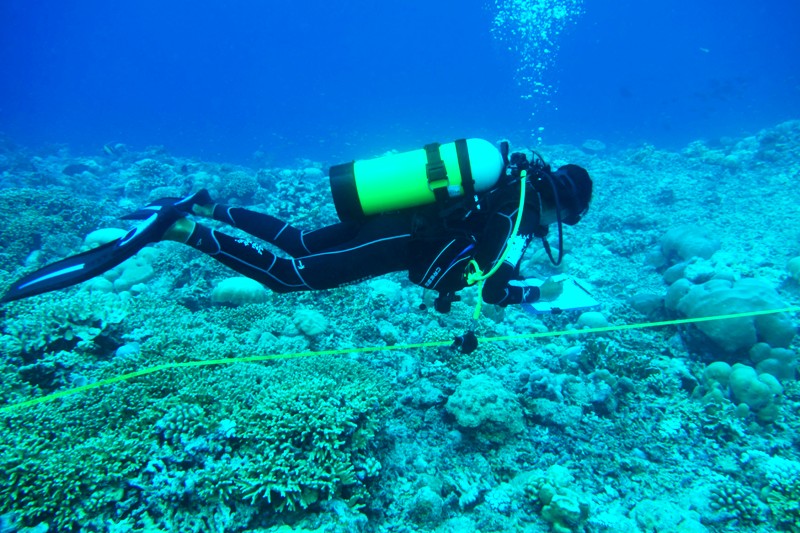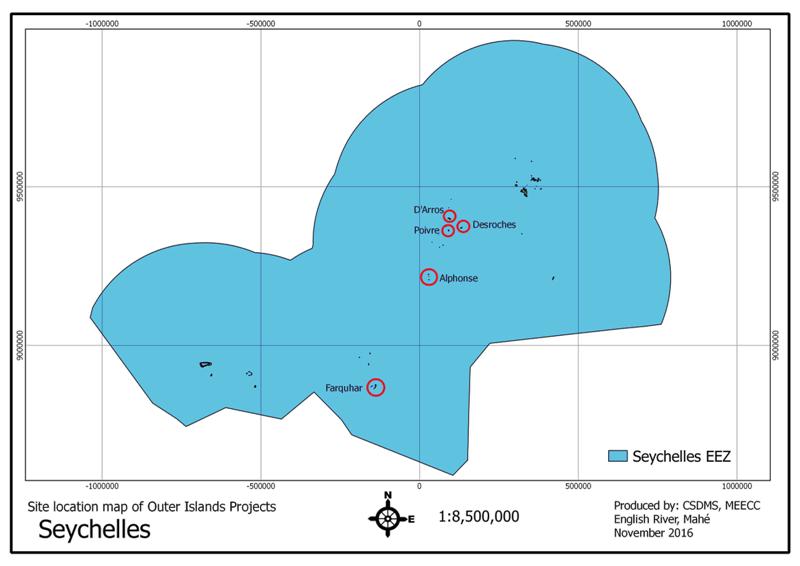Establishing protected areas on the outer islands |23 January 2017
Seychelles’ existing protected area system is primarily situated in the inner granitic islands, yet the outer coralline islands make up more than half of the total number of islands within the archipelago. The outer islands contain unique land and marine habitats, and species not found in the inner islands: for example they include 9 of the 20 internationally recognised Important Bird Areas (IBAs) of Seychelles. The GOS-UNDP-GEF Outer Islands project aims to place more of the unique habitats and biodiversity of the outer islands under protected area status!
What is the GOS-UNDP-GEF Outer Islands project and what is it trying to achieve?
The government of Seychelles has signed an agreement with the Global Environment Facility (GEF) and the United Nations Development Programme (UNDP) to implement a five-year project focused on the Outer Island (OI project). This project began in August 2014 and aims to promote the conservation and sustainable use of terrestrial and marine biodiversity in the Seychelles’ outer islands. It will do this by expanding the protected areas (PA) system and strengthening management of these areas, supporting the government Marine Spatial Planning process and sustainable land management activities to conserve ecosystem functions.
For more information visit: http://www.islandconservationseychelles.com/gos-undp-gef-outer-islands-project.html or www.pcusey.sc
Where do we start?
The islands of Seychelles cover 45,530ha of land and a vast marine area spanning 137,400,000ha. At present, 20,921ha of terrestrial landscapes and 34,847ha of marine seascapes are designated as protected. This represents 47% of the terrestrial area, but less than 1% of Seychelles Exclusive Economic Zone (EEZ), with the majority of the protected areas located around the inner islands.
In 2011, the government of Seychelles announced its intention to proclaim 9 new terrestrial protected areas, of which 8 are in the outer islands, namely (i) South Island Farquhar National Park; (ii) Goëlletes Island (Farquhar) and Banc de Sable Special Reserves; (iii) Grand and Petite Polyte Cosmoledo Special Reserve; (iv) Grand Ile (Cosmoledo) Area of Outstanding Natural Beauty; (v) Saint François and Bijoutier National Park; (vi) Assumption Island National Park; (vii) Desnoeufs Island Area of Outstanding Natural Beauty; and (viii) South Island (Poivre) National Park. If and when these sites are fully gazetted, the Seychelles will become the first country globally to designate more than 50% of its terrestrial territory as protected. The Outer Islands project supports the establishment of some of these new protected areas: Farquhar group, St François and Bijoutier and Poivre.
In December 2015, the government signed a Debt-for-Adaptation swap that commits the country to putting up to 30% of its marine area under protection. The Marine Spatial Planning process led by Government, and supported by The Nature Conservancy, aims to develop a consensus on how to proceed with this ambitious objective. The Outer Islands project works at a smaller scale, focusing on specific island groups, but will contribute towards this greater goal.
Who is involved?
All of the outer islands of Seychelles (except D’Arros and St Joseph Atoll) are owned by the Seychelles government. With the exception of Aldabra, the islands are leased for 99 years to the Islands Development Company (IDC), a corporation formed in 1980 to develop and supervise economic activities on the outer islands. In 2004, IDC signed a MoU with the Island Conservation Society (ICS) to provide conservation advisors on all islands owned by IDC. Currently, ICS has conservation officers based on Desroches, Alphonse and Farquhar, as well as on Silhouette (also managed by IDC) and Aride.
The Outer Islands project is based on a partnership between the Ministry of Environment, Energy and Climate Change (MEECC), the IDC, the ICS, the Save Our Seas Foundation, and other stakeholders. The aim of the partnership is to create and manage three new Protected Areas – Alphonse (Alphonse, St. François and Bijoutier), Poivre (South Island), Farquhar (South Island, Ile Goellette and Banc du Sable), and potentially to bring a fourth area Desroches, under improved conservation management. These islands were selected based on 3 primary criteria: presence of critically important biodiversity and ecosystem, availability of infrastructure and personnel to facilitate logistics, and existing or planned tourism development which would provide significant and on-going financing for Protected Area management at each site. Including D’Arros (St. Joseph), which is working independently to achieve protected area status, this would bring 76,258ha of marine ecosystems and 1,237ha of terrestrial ecosystems under improved conservation management.
Why do we need to protect the outer islands?
The existing system of protected areas in the outer islands is inadequate to protect all habitats and species. There is an urgent need to ensure the representation of the terrestrial and marine ecosystems of the outer islands in the country’s protected area network, and also to promote sustainable tourism development on these islands that supports effective mitigation of threats to biodiversity or to ecosystem functioning. Parts of these unique coralline island groups will be designated as Strict Nature Reserves or National Parks, whereas others will be Sustainable Use Areas. Managed together, these areas will help alleviate the threat from uncontrolled fishing, poaching and unsustainable development, as well as adapting to threats related to climate change.
Each of the target islands is special in its own right and it is our duty to ensure that we do not lose our natural heritage. The outer reef wall of Desroches features a series of caves and tunnels, which support larger species such as Napoleon Wrasse and Giant Grouper, the latter now scarce in Seychelles. Desroches is also home to two species of endemic cockroaches – (Delosia ornata and Margatteoidea amoena). The reef at St. François (Alphonse) is thought to be one of the most important foraging areas for immature turtles in the western Indian Ocean while the island itself supports globally significant numbers of Black-naped Terns (Strena sumatrana), crab plover (Dromas ardeola) and Saunders’ tern (Strena saudersii). Studies by Seychelles Fishing Authority have shown that the abundance of some grouper species at Farquhar is three times greater than in the north Amirantes and up to thirty times that of the granitic islands. In fact, the density of Napoleon Wrasse (Cheilinus undulates) may be the highest in the world, possibly rivalled only by numbers in the Cocos Keeling Islands.
How (and when) are we going to achieve our goals?
The GOS-UNDP-GEF Outer Islands Project has five-year to achieve its targets, facilitated by the approval of a new Nature Reserves and Conservancy Act.
Project actions include: an assessment of the current state of the proposed new protected areas; gazetting of boundaries and zoning of critical areas; strengthening of management structures and the preparation of Land Use Plans, Management Plans and strategic Business Plans; and the development of functional and well-trained teams of PA staff working in collaboration with IDC, tourism partners and other user groups at each site. To enable sustainable land management, the project will ensure the establishment of the necessary institutional framework, information and planning systems, and where necessary will work on the restoration of terrestrial ecosystems degraded by past unsustainable activities or, in the case of Farquhar, by Cyclone Fantala. The project will also establish mechanisms to prevent and control invasive alien species, which are increasingly prevalent on the inner islands.
National Protected Areas Day
National Protected Areas Day will be celebrated on January 31, 2017, with several activities being organised by the GOS-UNDP-GEF Programme Coordination Unit and its partners – particularly the Environmental Education Unit, the Department of Education and the Public Education and Community Outreach (PECO) at the Ministry of Environment, Energy and Climate Change. We invite the Seychellois public to join us to celebrate the importance of protected areas. Keep updated through our facebook page: GOS/UNDP/GEF-Programme Coordination Unit.


Contributed




